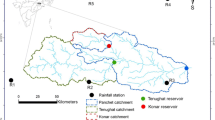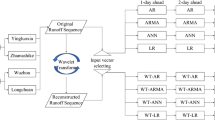Abstract
A new hybrid model, the wavelet–bootstrap–multiple linear regression (WBMLR) is proposed to explore the potential of wavelet analysis and bootstrap resampling techniques for daily discharge forecasting. The performance of the developed WBMLR model is also compared with five more models: multiple linear regression (MLR), artificial neural network (ANN), wavelet-based MLR (WMLR), wavelet-based ANN (WANN) and wavelet–bootstrap–ANN (WBANN) models. Seven years of discharge data from seven gauging stations in the middle reaches of Mahanadi river basin in India are applied in this study. Significant input vectors are decomposed into discrete wavelet components (DWCs) using discrete wavelet transformation (DWT) to generate wavelet sub time series that are used as inputs to the MLR and ANN models to develop the WMLR and WANN models, respectively. Effective wavelets are selected by considering several types of wavelets with different vanishing moments. WBMLR and WBANN models are developed as ensemble of different WMLR and WANN models, respectively, developed using different realizations of the training dataset generated using bootstrap resampling technique. The results show that the wavelet bootstrap hybrid models (i.e. WBMLR and WBANN) produce significantly better results than the traditional MLR and ANN models. Hybrid models based on MLR (WMLR, WBMLR) perform better than the ANN based hybrid models (WBANN, WANN). The WBMLR and WMLR models simulate the peak discharges better than the WBANN, WANN, MLR and ANN models, whereas the overall performance of WBMLR model is found to be more accurate and reliable than the remaining five models.





Similar content being viewed by others
References
(2013) Water resources information system of India
Abrahart RJ, Anctil F, Coulibaly P, Dawson CW, Mount NJ, See LM, Shamseldin AY, Solomatine DP, Toth E, Wilby RL (2012) Two decades of anarchy? Emerging themes and outstanding challenges for neural network river forecasting. Prog Phys Geogr 36(4):480–513
Adamowski J, Chan HF (2011) A wavelet neural network conjunction model for groundwater level forecasting. J Hydrol 407:28–40
Adamowski J, Sun K (2010) Development of a coupled wavelettransform and neural network method for flow forecasting of non-perennialrivers in semi-arid watersheds. J Hydrol 390:85–90
Adamowski J, Chan HF, Prasher SO, Zielinski BO, Sliusarieva A (2012) Comparison of multiple linear and nonlinear regression, autoregressive integrated moving average, artificial neural network, and wavelet artificial neural network methods for urban water demand forecasting in Montreal, Canada. Water Resour Res 48(1), W01528. doi:10.1029/2010WR009945
Ahmad SS, Simonovic SP (2011) A three-dimensional fuzzy methodology for flood risk analysis. J Flood Risk Manag 4:53–74
Anctil F, Tape DG (2004) An exploration of artificial neural network rainfall-runoff forecasting combined with wavelet decomposition. J Environ Eng Sci 3:S121–S128
Barreto H, Howland FM (2006) Introductory econometrics: using Monte Carlo simulation with Microsoft Excel. Cambridge University Press, Cambridge
Bishop CM (1995) Neural networks for pattern recognition. Clarendon, Oxford
Daubechies I (1990) The wavelet transform, time-frequency localization and signal analysis. IEEE Trans Inf Theory 36(5):6–7
Efron B, Tibshirani RJ (1993) An Introduction to the bootstrap. Chapman and Hall, London
Feng L-H (2013) Flood forecasting at the Dadu River in China based on ANN. Expert Syst 30(5):398–402
Haykin S (1994) Neural networks: a comprehensive foundation. Macmillan College Publishing Co., New York
Jain SK, Sudheer KP (2008) Fitting of hydrologic models: a close look at the Nash- Sutcliffe index. J Hydrol Eng 13(10):981–986
Jain A, Varshney K, Joshi UC (2001) Short-term water demand forecast modelling at iit kanpur using artificial neural networks. Water Resour Manag 15(1):299–321
Kant A, Suman PK, Giri BK, Tiwari MK, Chatterjee C, Nayak PC, Kumar S (2013) Comparison of multi-objective evolutionary neural network, adaptive neuro-fuzzy inference system and bootstrap-based neural network for flood forecasting. Neural Comput Applic 23(SUPPL 1):S231–S246. doi:10.1007/s00521-013-1344-8
Kim TW, Valdes JB (2003) Nonlinear model for drought forecasting based on a conjunction of wavelet transforms and neural networks. J Hydrol Eng 8(6):319–328
Kisi O, Shiri J (2012) Discussion on precipitation forecasting using wavelet-genetic programming and wavelet-neuro-fuzzy conjunction models. Water Resour Manag. doi:10.1007/s 11269-012-0060-y
Koutsoyiannis D (2007) Discussion of “generalized regression neural networks for evapotranspiration modelling” by O Kisi (2006). Hydrol Sci J 52(4):832–835
Magar RB, Jothiprakash V (2011) Intermittent reservoir daily-inflow prediction using lumped and distributed data multi-linear regression models. J Earth Syst Sci 120(6):1067–1084
Maier HR, Dandy GC (2010) Neural networks for the prediction and forecasting of water resources variables: a review of modelling issues and applications. Environ Model Softw 15:101–124
Mehta R, Jain SK (2009) Optimal operation of a multi-purpose reservoir using neuro-fuzzy technique. Water Resour Manag 23:509–529
Mukerji A, Chatterjee C, Raghuwanshi NS (2009) Flood forecasting using ann, neuro-fuzzy, and neuro-GA models. J Hydrol Eng 14(6):647–652
Muller B, Reinhardt J (1991) Neural networks—an introduction. Springer, Berlin
Nalley D, Adamowski J, Khalil B (2012) Using discrete wavelet transforms to analyze trends in streamflow and precipitation in Quebec and Ontario (1954–2008). J Hydrol 475(19):204–228
Nanavati SP, Panigrahi PK (2004) Wavelet transform: a new mathematical microscope. Resonance 9(3):50–64
Nayak PC, Venkatesh B, Krishna B, Jain SK (2013) Rainfall-runoff modeling using conceptual, data driven, and wavelet based computing approach. J Hydrol 493(17):57–67
Nourani V, Alami MT, Aminfar MH (2008) A combined neuralwavelet model for prediction of watershed precipitation, Ligvanchai, Iran. J Environ Hydrol 16(2):1–12
Nourani V, Komasi M, Mano A (2009) A multivariate ANN-wavelet approach for rainfall–runoff modeling. Water Resour Manag 23(14):2877–2894
Partal T, Cigizoglu HK (2008) Estimation and forecasting of daily suspended sediment data using wavelet–neural networks. J Hydrol 358(3–4):317–331
Rath S, Nayak PC, Chatterjee C (2013) Hierarchical neurofuzzy model for real-time flood forecasting. Int J Riv Basin Manag 11(3):253–268. doi:10.1080/15715124.2013.798329
Sahay RR, Sehgal V (2013) Wavelet regression models for predicting flood stages in rivers: a case study in Eastern India. J Flood Risk Manag 6(2):146–155
Sahay RR, Srivastava A (2014) Predicting monsoon floods in rivers embedding wavelet transform, genetic algorithm and neural network. Water Resour Manag 28:301–317
Sehgal V, Sahay RR, Chatterjee C (2014) Effect of utilization of discrete wavelet components on flood forecasting performance of wavelet based ANFIS models. Water Resour Manag. doi:10.1007/s11269-014-0584-4
Tiwari MK, Adamowski JF (2013) Urban water demand forecasting and uncertainty assessment using ensemble wavelet-bootstrap-neural network models. Water Resour Res 49(10):6486–6507
Tiwari MK, Chatterjee C (2010) Development of an accurate and reliable hourly flood forecasting model using wavelet-bootstrap-ANN hybrid approach. J Hydrol 394:458–470
Tiwari MK, Chatterjee C (2011) A new wavelet-bootstrap-ANN hybrid model for daily discharge forecasting. J Hydroinf 13(3):500–519
Tiwari MK, Song KY, Chatterjee C, Gupta MM (2013) Improving reliability of river flow forecasting using neural networks, wavelets and self-organizing maps. J Hydroinf 15(2):486–502. doi:10.2166/hydro.2012.130
Wang D, Ding J (2003) Wavelet network model and its application to the prediction of hydrology. Nat Sci 1(1):67–71
Zhou HC, Peng Y, Liang GH (2008) The research of monthly discharge predictor-corrector model based on wavelet decomposition. Water Resour Manag 22(1):217–227
Author information
Authors and Affiliations
Corresponding author
Rights and permissions
About this article
Cite this article
Sehgal, V., Tiwari, M.K. & Chatterjee, C. Wavelet Bootstrap Multiple Linear Regression Based Hybrid Modeling for Daily River Discharge Forecasting. Water Resour Manage 28, 2793–2811 (2014). https://doi.org/10.1007/s11269-014-0638-7
Received:
Accepted:
Published:
Issue Date:
DOI: https://doi.org/10.1007/s11269-014-0638-7




